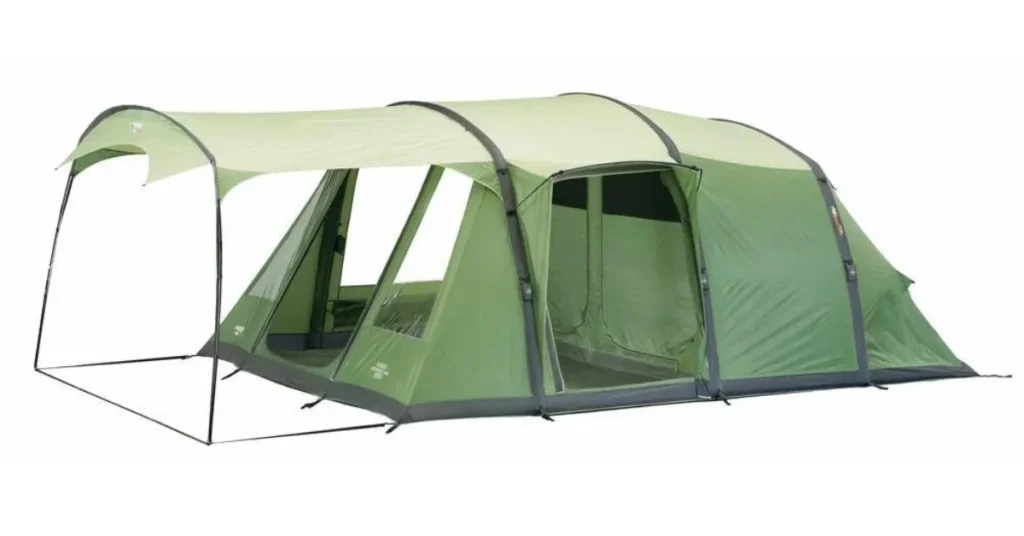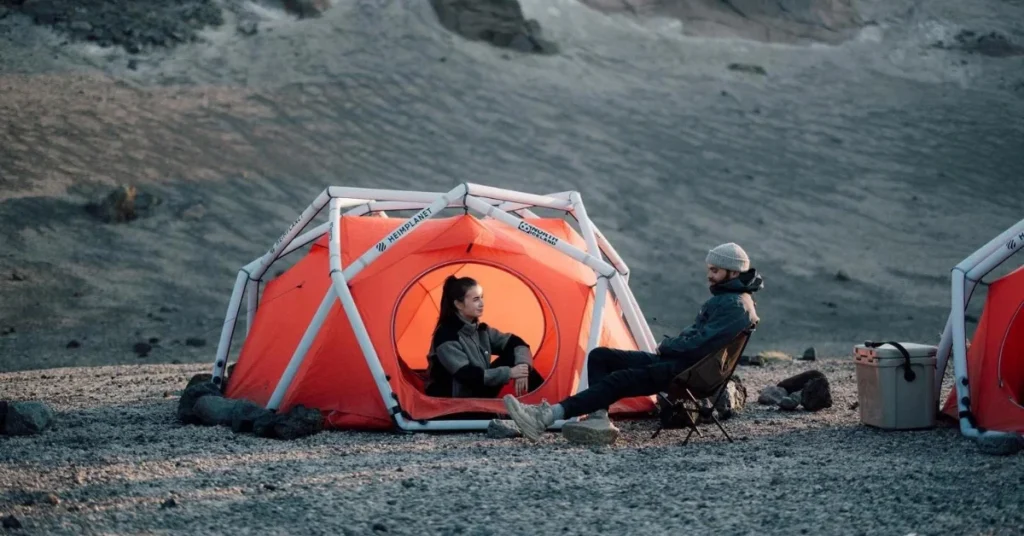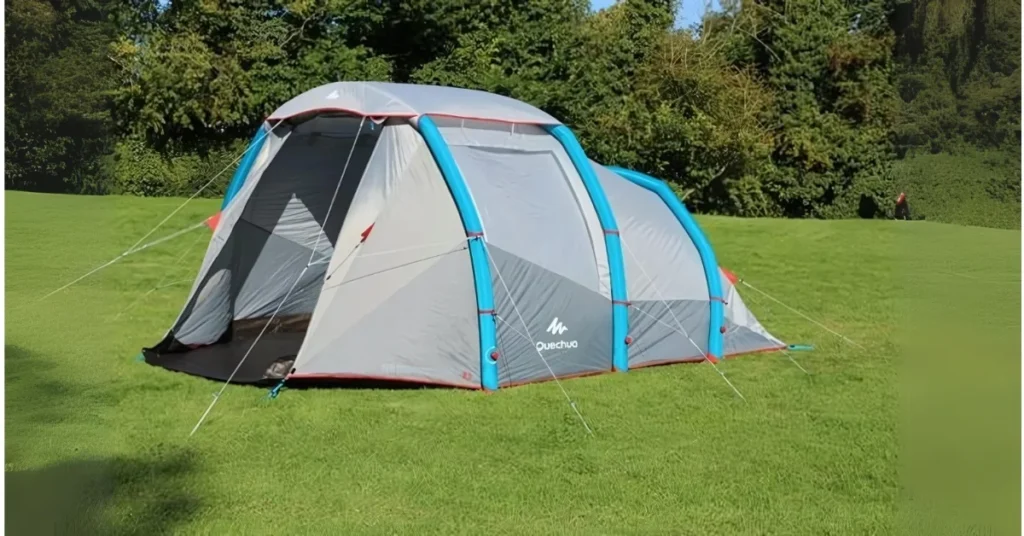Camping has evolved dramatically over the years, and one of the most significant innovations in outdoor gear is the inflatable tent. Also known as blow-up tents, these modern marvels are designed for quick and easy setup, offering a hassle-free experience compared to traditional pole-based tents. Whether you’re a seasoned camper or a beginner, air beam tents provide a convenient and comfortable solution that enhances your outdoor adventure.
In this comprehensive guide, we’ll delve into everything you need to know about air-supported tents from their key features and benefits to the pros and cons and how they compare to traditional tents. We’ll also explore the top brands, like Vango and Heimplanet, and offer tips on choosing the right air pole tent for your needs.
What is an Inflatable Tent?
Overview of Inflatable Tents
An air tent is a type of camping tent that replaces traditional poles with air beams. These beams are filled with air to create a sturdy structure, providing stability and support. The concept of air-inflated tents is rooted in air technology, which allows for quick inflation and deflation, making setup and takedown much easier than with conventional tents.
Key Features of Inflatable Tents
- Air Beams: Instead of rigid poles, airframe tents use air beams that are pumped up to form the tent’s structure. These beams are typically made from durable materials like thermoplastic polyurethane (TPU) to ensure they can withstand pressure and wear.
- Lightweight Materials: Blow-up tents are constructed using lightweight yet durable fabrics such as ripstop nylon or polyester. These materials are often reinforced at crucial points to enhance durability and weather resistance.
- Quick Setup: One of the standout features of air-supported tents is their quick and easy setup. With the use of an air pump—manual or electric—you can have your tent ready in a matter of minutes.
- Compact Storage: After use, pneumatic tents can be deflated and packed into a compact size, making them easy to transport and store.
How Inflatable Tents Work
The working principle of an air pole tent is simple yet effective. The tent’s beams are filled with air using a pump, creating a rigid structure that supports the fabric. Once inflated, the tent is stable and can withstand various weather conditions, including strong winds. It’s crucial to ensure that the beams are adequately inflated to maintain the tent’s shape and stability throughout your camping trip.
Benefits of Using a Blow-Up Tent
Ease of Setup
One of the most significant advantages of air-inflated tents is their ease of setup. Unlike traditional tents that require assembling poles and threading them through fabric loops, an air tent only needs air. Most models can be fully inflated within 5 to 10 minutes, allowing you to spend more time enjoying your camping experience.
Stability and Durability
Air chamber tents offer excellent stability, especially in windy conditions. The air beams flex with the wind rather than resisting it like rigid poles, reducing the risk of breakage. Additionally, the materials used in air tube tents are often designed to withstand harsh weather, ensuring that the tent remains durable over time.
Lightweight and Portable
Airframe tents are designed with portability in mind. The lightweight materials and compact storage size make them easy to carry, whether you’re backpacking or car camping. Some air-supported tents are so lightweight that they can be carried in a backpack, making them ideal for solo campers or those who prefer minimalist camping.
Versatility in Size and Design
Blow-up tents come in various sizes and designs to accommodate different needs. Whether you’re camping solo or with a large family, there’s an air pole tent to suit your requirements. Some models even feature multiple rooms, including living areas, sleeping quarters, and porches, providing ample space for comfort and convenience.
Safety and Comfort
The absence of metal or fiberglass poles in air-inflated tents reduces the risk of injury, making them a safer option, especially for families with young children. The air-filled beams also provide a bit of flexibility, which can be more comfortable in windy conditions. Moreover, many self-inflating tents come with built-in ventilation systems, solid windows, and waterproof materials, ensuring a comfortable and weather-resistant camping experience.
Inflatable Tents vs. Traditional Tents
Setup Time
Traditional tents can be time-consuming to set up, especially if you’re dealing with multiple poles and complex designs. Pop-up air tents, on the other hand, require significantly less time and effort. With just a pump and a few minutes, your tent is ready to go.
Weight and Portability
While traditional tents can vary in weight, they often require more storage space and can be heavier due to the poles. Air beam tents are generally lighter and pack down more compactly, making them easier to transport.
Durability and Stability
Both types of tents offer durability, but air-supported tents have edge instability, particularly in windy conditions. The flexibility of air beams allows them to bend with the wind, reducing the likelihood of damage.
Comfort and Space
Air-inflated tents often provide more interior space and comfort compared to traditional tents. The lack of rigid poles means there’s more usable space inside the tent, and many models include separate rooms for sleeping and living.
Price Comparison
Air beam tents tend to be more expensive than traditional tents due to the advanced materials and technology used in their construction. However, the convenience and comfort they offer can justify the higher price for many campers.
Popular Brands and Models
Vango
Vango is one of the leading brands in the air tent market, known for its high-quality designs and innovative features. Their AirBeam range is particularly popular, offering models that cater to both solo campers and large families.

- Vango Odyssey Air 500: A great choice for family camping, this tent offers a spacious interior with multiple rooms and excellent weather resistance.
- Vango AirBeam Mirage: Ideal for smaller groups or solo adventurers, this tent is lightweight and easy to set up, with robust weatherproofing features.
Heimplanet
Heimplanet is another top brand, famous for its unique geometric designs and durable materials. Their tents are built to withstand extreme weather conditions, making them a favorite among serious campers.

- Heimplanet The Cave: This is Heimplanet’s flagship model, featuring a geodesic design that offers exceptional stability and strength. It’s perfect for challenging environments.
- Heimplanet Fistral: A compact and lightweight option, the Fistral is designed for solo campers or small groups who need a reliable and easy-to-use tent.
Quechua
Quechua offers budget-friendly, air-supported tents that don’t compromise on quality. Their tents are known for their user-friendly designs and durability, making them a great option for casual campers.

- Quechua Air Seconds 4.1 XL: This tent is perfect for families, offering ample space and an integrated living area, all at an affordable price.
- Quechua Fresh & Black: Designed with darkened fabric to block out sunlight, this tent is ideal for those who value a good night’s sleep while camping.
Pros and Cons of Inflatable Tent
Pros
- Quick and Easy Setup: Inflatable tent can be set up in minutes, making them ideal for campers who want to spend more time enjoying the outdoors.
- Enhanced Stability: The flexible air beams provide better wind resistance than traditional poles, reducing the risk of damage during storms.
- Lightweight and Portable: These tents are easy to carry and pack, making them a convenient choice for various types of camping trips.
- Versatile Designs: With a range of sizes and layouts, air-supported tents can accommodate different camping needs, from solo trips to family vacations.
Cons
- Higher Price Point: Air-inflated tents are generally more expensive than traditional tents due to their advanced technology and materials.
- Dependence on a Pump: Without a functioning pump, setting up an air beam tent can be challenging, so it’s crucial to have a reliable air pump on hand.
- Repair Challenges: While air pole tents are durable, punctures or leaks in the air beams can be more challenging to repair compared to traditional tent poles.
- Weight: Although airframe tents are lighter than some traditional tents, the added weight of the air pump can be a downside for backpackers.
Key Considerations When Buying an Air Tent
Size and Capacity
Consider how many people will be using the tent and how much space you need. inflatable tent come in various sizes, from compact models for solo campers to large family tents with multiple rooms.
Weather Resistance
Check the tent’s waterproof rating and wind resistance. Look for models with a high waterproof rating and strong wind resistance to ensure your tent can withstand various weather conditions.
Weight and Portability
If you plan to carry the tent for long distances, consider the weight and how compactly it packs down. Some air-inflated tents are designed for car camping, while others are light enough for backpacking.
Ease of Setup
Ensure that the tent comes with a reliable air pump and is easy to set up. Some models include additional features like quick-inflation valves or color-coded air beams for even easier assembly.
Price and Value for Money
Consider your budget and compare the features offered by different models. While air-beam tents can be more expensive, investing in a high-quality tent can pay off in terms of durability and ease of use.
Conclusion
Air tents have revolutionized the way we camp, offering a blend of convenience, comfort, and innovation. Whether you’re a seasoned camper looking to upgrade your gear or a beginner seeking an easy-to-use tent, air pole tents provide an excellent option. By understanding the key features, benefits, and considerations, you can choose the right air-supported tent for your next outdoor adventure.
With options from leading brands like Vango and Heimplanet, and a range of sizes and designs to choose from, finding the perfect air beam tent has never been easier. So, the next time you head out into the wilderness, consider the many advantages of an air-inflated tent and enjoy a hassle-free camping experience.
FAQs:
What is an inflatable tent?
An inflatable tent is a type of shelter that uses air-filled poles or beams to provide structure and support, rather than traditional rigid poles. It is quick to set up and offers a flexible and lightweight alternative to conventional tents.
How long does it take to set up an inflatable tent?
Inflatable tents can typically be set up in 5 to 15 minutes. Simply inflate the beams using a pump (manual or electric), and the tent will take shape. It’s much faster compared to setting up traditional pole tents.
Are inflatable tents durable?
Yes, inflatable tents are designed to be durable and withstand various weather conditions. They are made from strong, weather-resistant materials, and the inflatable beams are reinforced to ensure stability and resistance to pressure.
Can inflatable tents be used in all weather conditions?
Inflatable tents are generally designed to handle a range of weather conditions, including rain and wind. However, it’s important to check the manufacturer’s specifications for weather resistance and ensure proper anchoring and ventilation.
How do you maintain and repair an inflatable tent?
Maintenance involves regular cleaning and ensuring the tent is completely dry before storing it. For repairs, most inflatable tents come with a repair kit for small punctures or tears. If a major repair is needed, you may need to contact the manufacturer or a professional service.

